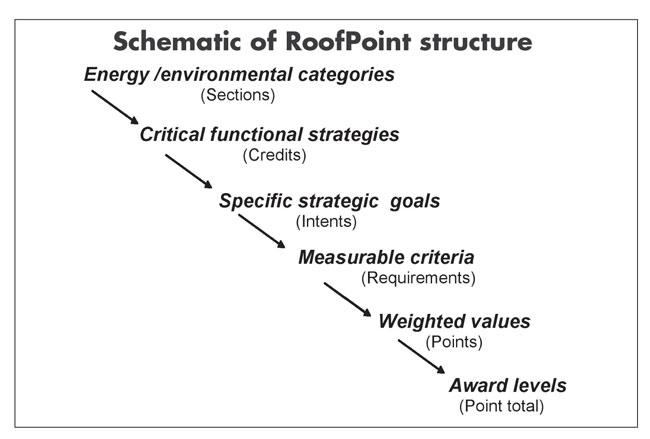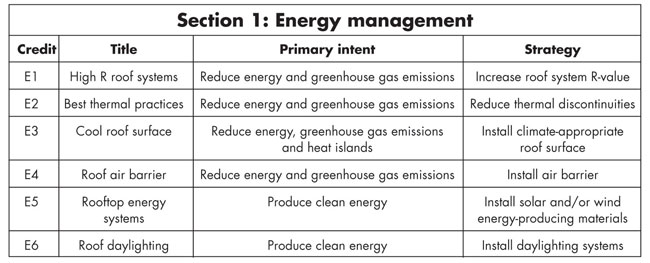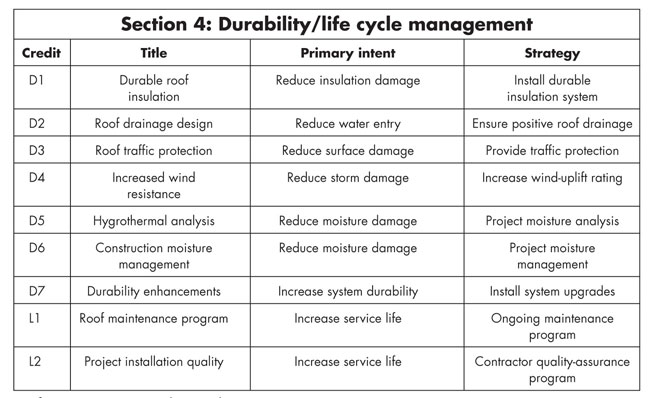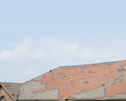Developed by the Center for Environmental Innovation in Roofing, RoofPoint is a roofing-specific version of green building rating systems that have emerged to promote an environmentally responsible built environment. Similar to how whole-building rating systems promote professionalism, RoofPoint embraces a mission to elevate the professional practice of everyone involved in the roofing process to a higher level of accomplishment and recognition; it involves four components.

RoofPoint's structure
RoofPoint is a guideline for the selection of environmentally innovative roof systems and roof systems that maximize energy efficiency and longevity while minimizing negative environmental effects. In addition, RoofPoint serves as a checklist to identify the many ways roof systems provide economic and environmental benefits. RoofPoint also serves as an assessment system to compare different roofing alternatives for a particular environmental application. Finally, RoofPoint provides a platform for a comprehensive certification program to recognize and reward environmentally responsible roofing practices.
Why is it needed?
RoofPoint helps showcase the roofing industry's vital role in supporting U.S. energy security. Nonresidential roof systems cover more than 50 billion square feet of developed space in the U.S., according to the center. If effectively used, this vast area of roof surface can deliver enormous benefits through energy efficiency and clean energy production. A recent study prepared by my company, TEGNOS Research Inc., Carmel, Ind., for the center estimates the total energy potential to exceed the combined output of 25 Grand Coulie Dams.
Because of this untapped potential, energy-efficient, environmentally responsible roof systems are gaining increased public visibility. Just this year, Secretary of Energy Steven Chu endorsed the value of energy-efficient roof systems and mandated an R-30 reflective roof system should be the minimum benchmark for all facilities.
In addition to policymakers such as Chu, building designers and owners also are interested in making better roofing decisions. Increasingly, buildings' roof systems are becoming a focal point for the benefits of green construction, bringing opportunities for enhanced occupant satisfaction, increased rents and stable property values. RoofPoint is targeted toward this increased public interest, further increasing roofing's visibility and helping building designers and owners put this increased interest into daily practice.

RoofPoint's Section 1 and its credits
Although roof systems' energy potential is significant, no existing green building rating system effectively captures this potential. Rating systems for new buildings fail to address the reroofing market, which accounts for about two-thirds of the total roofing market and billions of square feet of annual opportunity. And rating systems for existing buildings only address roofing when it is part of a much larger renovation project. As a result, few standardized tools are available to building owners and designers to evaluate the environmental performance of roof system assets alone.
Roofing professionals also quickly recognized potential conflicts between the environmental ideals of green building rating systems and the practical realities of building construction and maintenance. Use of new technologies and materials in the roofing industry can be productive only if these technologies and materials do not adversely affect roof system longevity and serviceability.
For example, an aged roof leaking beneath a new roof-mounted photovoltaic (PV) array; unanticipated moisture movement in new roof system designs; and the serviceability of new, untested roofing products were just a few concerns raised within the industry. And as these concerns were raised, roofing professionals recognized better guidelines are needed to address these issues.
With RoofPoint, the roofing industry will be recognized and rewarded for adding value to the environment and society. Using the guidelines established by RoofPoint, roofing becomes a value-added product as building owners trade up to more efficient, longer-lasting roof systems. And in the process, roofing becomes a value-added profession with an enhanced public image, increasing career opportunities and higher-paying job skills. Finally, the principles embodied in RoofPoint will help increase the industry's role as a value-added influence on public policy, as well as individual design and purchase decisions.

RoofPoint's Section 2 and its credits
In a nutshell, RoofPoint allows building owners and designers to make better decisions, and the roofing industry benefits by transforming these decisions into as-built realities.
How did it develop?
The concept behind RoofPoint originated with key leaders from the roofing contracting and manufacturing communities. Because the center offers a unique forum for these industry leaders, the first formal mandate for a system like RoofPoint was initiated by the center's board of directors.
Recognizing the center's mission is to serve as a unified voice for the industry for energy and environmental matters, the board instructed the center's Research Committee to develop a guideline and rating system that would aid in the design and selection of roof systems offering long-term solutions to pressing energy and environmental needs.

RoofPoint's Section 3 and its credits
Since the board's decision in the fall of 2009, the Research Committee has worked to fulfill the board's vision. Because the center's membership encompasses leading roofing organizations, the best technical minds in the industry participated actively in the development of RoofPoint. Between the members of the Research Committee and external stakeholders participating in a two-stage public review process, RoofPoint has been strenuously reviewed and vetted to provide the best possible roofing decision tool for building designers and owners.
However, the most important catalyst in RoofPoint's development occurred in the spring of 2010 when The Roofing Industry Alliance for Progress provided the center with a $750,000 grant to co-sponsor a strong national program to promote and administer RoofPoint.
At the time of the award, soon-to-be Rep. Reid Ribble (R-Wis.), president of the Alliance and former president of The Ribble Group, Kaukauna, Wis., stated: "The Alliance believes RoofPoint will become a valuable tool for the roofing industry. It has the potential to grow our industry, expand the role of the rooftop, lead to the development of innovative clean technologies, and deliver new economic and environmental benefit to building owners and occupants."
How it works
RoofPoint is organized into five functional areas representing the primary environmental contributions of modern low-slope roof systems: energy management, materials management, water management, life cycle management and roofing innovation. Each area is further organized into a series of credits based on the critical determinants of each primary environmental function.

RoofPoint's Section 4 and its credits
Roof system assessment is based on a distribution of points among the guideline credits. Point distribution is related to the potential environmental consequences of each credit within the five functional areas.
The consequences represent the key environmental effects of the design, construction, operation and maintenance of the roof system in question, including net fossil energy consumption, greenhouse gas and other atmospheric emissions, heat island effects, solid waste effects, water consumption and pollutants. A combination of approaches, including energy modeling, life cycle assessment and transportation analysis, is then used to establish the relative weight of each type of effect.
Current status
The first draft of RoofPoint available for public use is the "RoofPoint Guideline for Environmentally Innovative Commercial Roofing." This guideline, which is available from the center's website (www.roofingcenter.org), provides a comprehensive roadmap for the design, selection, installation and maintenance of commercial roof systems. The current draft can be used for a wide variety of low- and steep-slope roof systems. In addition, RoofPoint can be used with roof systems installed completely above the roof deck or over an attic space, structural metal roof systems and combinations of these systems.

RoofPoint's Section 5 and its credits
Currently, center members are working to identify and qualify roofing projects for an initial pilot program. The pilot program's objectives include refining RoofPoint into an effective decision tool, developing professional expertise in the use of the RoofPoint system and building public awareness of RoofPoint's value. In support of this effort, Research Committee members are serving as the first RoofPoint Professionals who will be certified to assist building owners and managers with the application of RoofPoint.
The pilot program will culminate by the summer of 2011 with the public recognition of the first RoofPoint Certified Roofing Systems evaluated and qualified under this program.
2011 and beyond
After the pilot program concludes, the center plans to formalize the roof system certification process and make the program available to the general public.
In addition, the center will develop a certification program for RoofPoint Registered Professionals to support the roofing project certification process.
To ensure the RoofPoint guideline will evolve into an established industry standard, the center also will begin creating a formal development model for the ongoing support of RoofPoint using the American National Standards Institute or similar consensus process. Finally, additional versions of RoofPoint will be published, starting with a residential version targeted to homebuilders and homeowners.
Getting involved
RoofPoint will support an important transformation in the roofing industry. As the concepts of RoofPoint become integrated into everyday roof system design and installation, roofing customers will receive better, longer-lasting, environmentally friendly roof systems, and the roofing industry will receive increased recognition and opportunity for growth.
Jim Hoff, Ph.D., serves as research director for the Center for Environmental Innovation in Roofing and president of TEGNOS Research Inc., Carmel, Ind., an independent consultancy.



